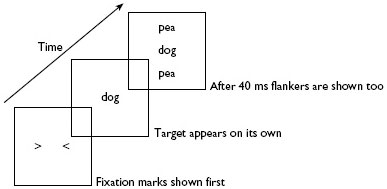3.4 The ‘flanker’ effect
A potential problem for the feature integration theory is the fact that the time taken to understand the meaning of a printed word can be influenced by other, nearby words. Of itself, this is not surprising, because it is well known that one word can prime (i.e. speed decisions to) another related word; the example nurse – doctor was given in Section 1.4. However, Shaffer and LaBerge (1979) found priming effects, even when they presented words in a way which might have been expected to eliminate priming. For their experiment a word was presented on a screen, and as quickly as possible a participant had to decide to what category it belonged; for example an animal or a vegetable. The participant was required to press one button for animal names, and another for vegetables. This sounds straightforward, but the target word was not presented in isolation; above and below it another word was also printed, making a column of three words. The target, about which a decision was to be made, was always in the centre. The words repeated above and below the target were termed the ‘flankers’. Before the three words were displayed, markers in the field of view showed exactly where the target would appear. Figure 7 shows examples of possible displays.

You will probably not be surprised to learn that people make category judgements more quickly for examples such as that shown in Figure 7a than for the Figure 7b type of stimulus. Presumably, while the target information is being processed, details about the flankers are also being analysed, in parallel. When they turn out to be from the category associated with pressing the other button they slow the response. This slowing is very much like the impact of the conflicting colour names in the Stroop effect (see Box 2). However, recall that Treisman's theory suggests that focused, serial attention is required to join features together. A printed word has many features, and it would be thought that they require joining before the word can be recognised; it should not be possible to process the three words simultaneously. A participant focusing on the target could not (according to the theory) also be processing the flankers.
Box 2 Research study: The Stroop effect
Stroop (1935) reported a number of situations in which the processing of one source of information was interfered with by the presence of another. The best known example uses a list of colour names printed in non-matching coloured inks.
A variant is the ‘Emotional Stroop task’, which can be used in therapeutic diagnoses. For example, severe depression produces cognitive impairment and, in the elderly, it is difficult to distinguish this from the effects of the onset of dementia. Dudley et al. (2002) used colours to print a list of words, some of which were associated with negative emotions (e.g. the word sadness). Depressed people have an attentional bias towards such depression-related material. Patients were required to name the ink colours for each word, as quickly as possible. Both depressed patients and those in the early stages of Alzheimer's disease were slower than a control group, but only the patients with depression were extra slow in responding to negative words. The technique permits an appropriate diagnosis.
Click to view Plate 4: The Stroop effect. [Tip: hold Ctrl and click a link to open it in a new tab. (Hide tip)]
Broadbent addressed this problem (Broadbent and Gathercole, 1990), and produced an explanation to ‘save’ the feature integration theory. He suggested that the central target word primed the flankers so effectively that they could be detected with the minimum of attention. Taking the items in Figure 7 as an example, if this explanation were true it would have to be argued that ‘dog’ primes ‘cat’, which, being another animal leads to faster decision times. ‘Dog’ cannot prime ‘pea’, as they are unrelated, so there is nothing to make the decision any quicker. In other words, it is not that ‘pea’ makes responses to ‘dog’ harder; rather, ‘cat’ makes them easier. Broadbent and Gathercole tested this explanation with an ingenious modification to the usual way of presenting targets and flankers. Instead of displaying all three words simultaneously, the target appeared first, to be joined by the flankers 40 ms later. The sequence is represented in Figure 9.
The reasoning behind this change was as follows. If Broadbent and Gathercole were correct that the flankers were analysed only because of priming from the target word, then giving the target a ‘head start’ should enable it to prime even more effectively; the flanker effect would be even stronger. On the other hand, if interference from the flankers were merely an example of processing not being as ‘serial’ as Treisman supposed, then making flankers arrive late, when target processing had already started, should reduce their impact. The results showed a strong flanker effect (i.e. faster responses with same-category flankers), suggesting that the priming idea was correct. However, there is another interpretation of the Broadbent and Gathercole results. It has been well established that an item suddenly appearing in the visual field will capture attention (e.g. Gellatly et al., 1999). By making the flankers appear later, Broadbent and Gathercole may have ensured that they would attract attention away from the target. This could explain why the flankers showed a particularly strong effect with this style of presentation. Although the Broadbent and Gathercole idea of staggering the display times of the stimuli was ingenious, a convincing demonstration of parallel processing requires all the different stimuli to be presented at the same time.

